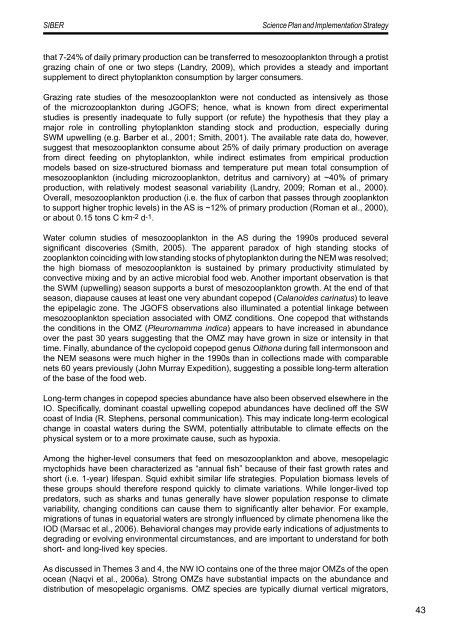SIBER SPIS sept 2011.pdf - IMBER
SIBER SPIS sept 2011.pdf - IMBER
SIBER SPIS sept 2011.pdf - IMBER
Create successful ePaper yourself
Turn your PDF publications into a flip-book with our unique Google optimized e-Paper software.
<strong>SIBER</strong><br />
Science Plan and Implementation Strategy<br />
that 7-24% of daily primary production can be transferred to mesozooplankton through a protist<br />
grazing chain of one or two steps (Landry, 2009), which provides a steady and important<br />
supplement to direct phytoplankton consumption by larger consumers.<br />
Grazing rate studies of the mesozooplankton were not conducted as intensively as those<br />
of the microzooplankton during JGOFS; hence, what is known from direct experimental<br />
studies is presently inadequate to fully support (or refute) the hypothesis that they play a<br />
major role in controlling phytoplankton standing stock and production, especially during<br />
SWM upwelling (e.g. Barber et al., 2001; Smith, 2001). The available rate data do, however,<br />
suggest that mesozooplankton consume about 25% of daily primary production on average<br />
from direct feeding on phytoplankton, while indirect estimates from empirical production<br />
models based on size-structured biomass and temperature put mean total consumption of<br />
mesozooplankton (including microzooplankton, detritus and carnivory) at ~40% of primary<br />
production, with relatively modest seasonal variability (Landry, 2009; Roman et al., 2000).<br />
Overall, mesozooplankton production (i.e. the flux of carbon that passes through zooplankton<br />
to support higher trophic levels) in the AS is ~12% of primary production (Roman et al., 2000),<br />
or about 0.15 tons C km-2 d-1.<br />
Water column studies of mesozooplankton in the AS during the 1990s produced several<br />
significant discoveries (Smith, 2005). The apparent paradox of high standing stocks of<br />
zooplankton coinciding with low standing stocks of phytoplankton during the NEM was resolved;<br />
the high biomass of mesozooplankton is sustained by primary productivity stimulated by<br />
convective mixing and by an active microbial food web. Another important observation is that<br />
the SWM (upwelling) season supports a burst of mesozooplankton growth. At the end of that<br />
season, diapause causes at least one very abundant copepod (Calanoides carinatus) to leave<br />
the epipelagic zone. The JGOFS observations also illuminated a potential linkage between<br />
mesozooplankton speciation associated with OMZ conditions. One copepod that withstands<br />
the conditions in the OMZ (Pleuromamma indica) appears to have increased in abundance<br />
over the past 30 years suggesting that the OMZ may have grown in size or intensity in that<br />
time. Finally, abundance of the cyclopoid copepod genus Oithona during fall intermonsoon and<br />
the NEM seasons were much higher in the 1990s than in collections made with comparable<br />
nets 60 years previously (John Murray Expedition), suggesting a possible long-term alteration<br />
of the base of the food web.<br />
Long-term changes in copepod species abundance have also been observed elsewhere in the<br />
IO. Specifically, dominant coastal upwelling copepod abundances have declined off the SW<br />
coast of India (R. Stephens, personal communication). This may indicate long-term ecological<br />
change in coastal waters during the SWM, potentially attributable to climate effects on the<br />
physical system or to a more proximate cause, such as hypoxia.<br />
Among the higher-level consumers that feed on mesozooplankton and above, mesopelagic<br />
myctophids have been characterized as “annual fish” because of their fast growth rates and<br />
short (i.e. 1-year) lifespan. Squid exhibit similar life strategies. Population biomass levels of<br />
these groups should therefore respond quickly to climate variations. While longer-lived top<br />
predators, such as sharks and tunas generally have slower population response to climate<br />
variability, changing conditions can cause them to significantly alter behavior. For example,<br />
migrations of tunas in equatorial waters are strongly influenced by climate phenomena like the<br />
IOD (Marsac et al., 2006). Behavioral changes may provide early indications of adjustments to<br />
degrading or evolving environmental circumstances, and are important to understand for both<br />
short- and long-lived key species.<br />
As discussed in Themes 3 and 4, the NW IO contains one of the three major OMZs of the open<br />
ocean (Naqvi et al., 2006a). Strong OMZs have substantial impacts on the abundance and<br />
distribution of mesopelagic organisms. OMZ species are typically diurnal vertical migrators,<br />
43












